Common issues with the M20 disk drives
by Davide BucciGeneral information about disk drives
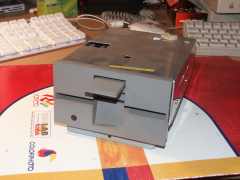 The Olivetti M20 disk drive unit (produced by OPE: Olivetti Peripherals) is a full size 5 and 1/4 inches unit and can be affected by several aging problems.
The first good habit to take is to store the machine with the disk drives open, as the heads can stick together.
The Olivetti M20 disk drive unit (produced by OPE: Olivetti Peripherals) is a full size 5 and 1/4 inches unit and can be affected by several aging problems.
The first good habit to take is to store the machine with the disk drives open, as the heads can stick together.
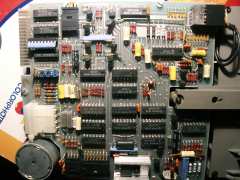 The electronic board of the disk drive contains rather standard components such as TTL integrated circuits, discrete transistors and resistors, capacitors. If you suspect a problem concerning this board, you should begin checking the most solicited components, such as the transistors controlling the motors, or the capacitors that can be dried out. The power transistor with the radiator controls the disk spin motor and is particularly prone to failure. If the activity LED is on, but the disk does not spin, check carefully this part.
The electronic board of the disk drive contains rather standard components such as TTL integrated circuits, discrete transistors and resistors, capacitors. If you suspect a problem concerning this board, you should begin checking the most solicited components, such as the transistors controlling the motors, or the capacitors that can be dried out. The power transistor with the radiator controls the disk spin motor and is particularly prone to failure. If the activity LED is on, but the disk does not spin, check carefully this part.
Andreas Senk reported this experience: "Disk drive 1 had run at full speed the whole time when the M20 was powered
up. A transistor named TIP115 was not working. I¥ve replaced it with the same type
and made a speed adjust."
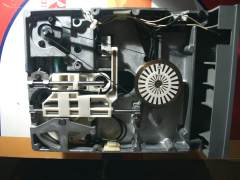 The mechanics of the drive is also one of the most frequent cause of failure. You should check that the belt is in good shape and that the motor drives correctly the spinning wheel. You can regulate the speed of the disc rotation by using the stroboscope principle and a fluorescent light.
Make the center wheel spin and, by observing it under a fluorescent light, the pattern that corresponds to the mains frequency in use in your country should stay still. Check also the head positioning system. Under the second motor, there is a spiral that sets the position of the head. Everything should move smoothly.
The mechanics of the drive is also one of the most frequent cause of failure. You should check that the belt is in good shape and that the motor drives correctly the spinning wheel. You can regulate the speed of the disc rotation by using the stroboscope principle and a fluorescent light.
Make the center wheel spin and, by observing it under a fluorescent light, the pattern that corresponds to the mains frequency in use in your country should stay still. Check also the head positioning system. Under the second motor, there is a spiral that sets the position of the head. Everything should move smoothly.
 If your drive seems to work unreliably, or is unable to be used for booting the system, can not read floppy written by other units, it is possible that there is an head misalignment problem. You can try to unscrew a little bit the stepper motor that controls the head position and to rotate it slightly, in order to see if you are able to improve the situation. Be careful, anyway! The head positioning is very sensitive and a slight error can make the drive not working at all. It is better to mark the initial position of the motor, in order to have a reference. More on this later.
If your drive seems to work unreliably, or is unable to be used for booting the system, can not read floppy written by other units, it is possible that there is an head misalignment problem. You can try to unscrew a little bit the stepper motor that controls the head position and to rotate it slightly, in order to see if you are able to improve the situation. Be careful, anyway! The head positioning is very sensitive and a slight error can make the drive not working at all. It is better to mark the initial position of the motor, in order to have a reference. More on this later.
Disk head align using an oscilloscope
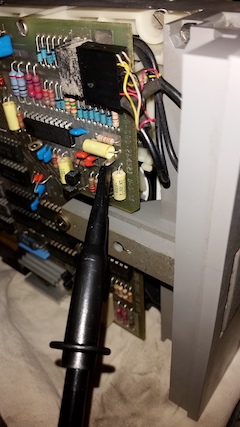 Many years ago (I'm writing this paragraph in December 2022), I had a phone call with a former Olivetti technician. He said to me that the standard procedure to align the disk drives involved an oscilloscope and a test disk. The idea was to set up the position of the head by optimizing the amplitude of an eye diagram on an analog oscilloscope. There are two test points in the drives, around the MC3470 IC, a floppy disk read amplifier. Easy enough, the first one gives the signal from the heads, whose amplitude should be maximized.
Many years ago (I'm writing this paragraph in December 2022), I had a phone call with a former Olivetti technician. He said to me that the standard procedure to align the disk drives involved an oscilloscope and a test disk. The idea was to set up the position of the head by optimizing the amplitude of an eye diagram on an analog oscilloscope. There are two test points in the drives, around the MC3470 IC, a floppy disk read amplifier. Easy enough, the first one gives the signal from the heads, whose amplitude should be maximized.
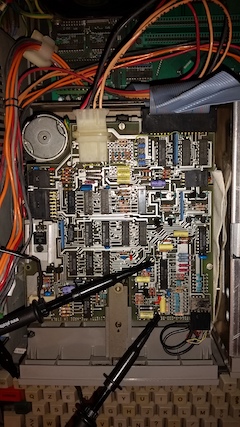 The second test point gives a TTL signal for the synchronization of the oscilloscope. The connection is very easy if you have an oscilloscope.
The second test point gives a TTL signal for the synchronization of the oscilloscope. The connection is very easy if you have an oscilloscope.
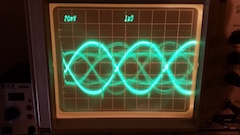 This picture show a typical signal. It is present only when the computer reads from the disk. Without the Olivetti original test disk, I wrote a simple BASIC program that continuously reads the directory of the disk ("files" command), ignoring any error. They will occur when the disk is out of alignment. I set up my oscilloscope as 1µs/div horizontal and 20mV/div vertical.
This picture show a typical signal. It is present only when the computer reads from the disk. Without the Olivetti original test disk, I wrote a simple BASIC program that continuously reads the directory of the disk ("files" command), ignoring any error. They will occur when the disk is out of alignment. I set up my oscilloscope as 1µs/div horizontal and 20mV/div vertical.
Page log
- July 26, 2023 - Corrected a small issue in character encoding.
- December 24, 2022 - Added the page log, added the Disk head align with an oscilloscope paragraph.
- June, 13, 2008 - Corrected some details.
- December 30, 2006 - Page creation.
Olivetti is a registered trademark of Telecom Italia. This site is not related to Olivetti nor to Telecom Italia. The material presented is meant for personal use only and is shared in a "fair use" spirit. If you own the copyright of some of the stuff presented here and you think it should be removed, please contact the webmaster.


